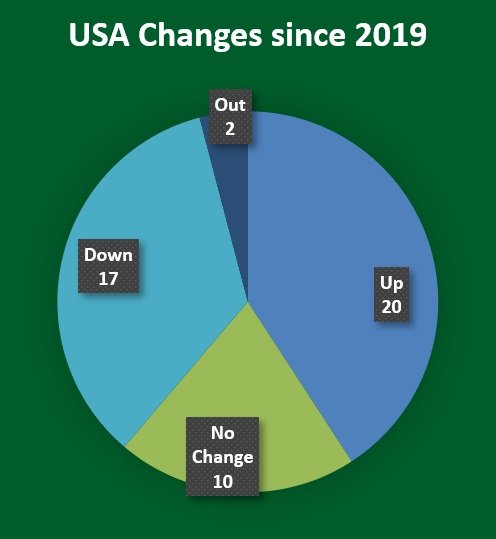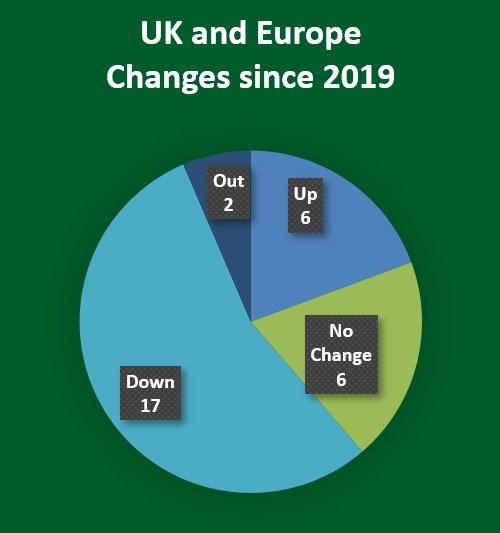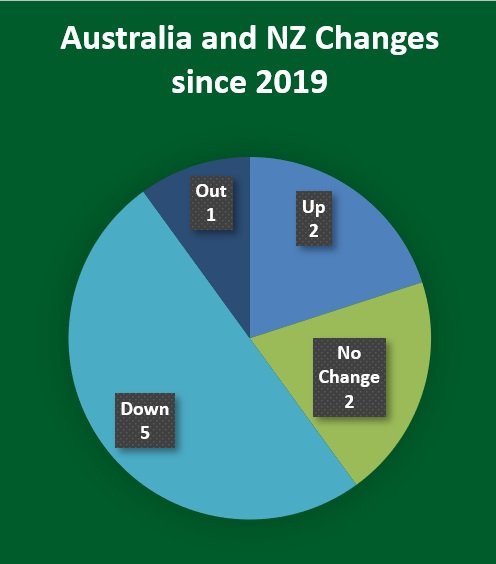The most eagerly awaited golf course ranking is out, and it certainly doesn’t fail when it comes to talking points and interest. GOLF magazine is a US-based magazine which has listed the top courses in the world since the mid-1980s. Other lists have come and gone, but GOLF keeps going.
The magazine is on sale in the US now. Hopefully they will put the content up on their website soon and I’ll link to it here when it is.
The last list, in 2019, marked a significant change for the magazine. Ran Morrissett, founder of Golfclubatlas.com and co-contributor to the Confidential Guide, took over as the Architecture Editor and the 2019 list was the first he had overseen. In a blog, I wrote about how he had significantly overhauled the panel and about the impact that had made.
Other US-based rating panels have thousands of members who pay for the privilege of joining - often in the hope of access to courses. GOLF magazine has none of that nonsense. Every rater is hand picked by Morrissett. Several of them are architects (Hanse, Doak and several of their associates are all on the list) though they are not allowed to vote on their own creations.
The panel has expanded this year, to 103 members. While it is a world top 100 ranking list, it comes very much from a North American perspective. 78 of the panel members are based in North America, only 6 are UK based. This is important to keep in mind when looking at the results. Given the events of the last couple of years, the vast majority of raters will have had far more recent exposure to US courses than those in the rest of the world. That absolutely shows up in the results.
A TRIUMPH FOR THE US
Whichever way you look at it, this list is something of a triumph for the US. American courses take an incredible 19 of the top 30 places.
It’s been a good few years since I last made a pie chart, but I think these tell the story well. Of the US courses in the 2019 list, 60% have kept or improved their positions. In Europe and AUS/NZ two thirds have dropped places.
So, what’s going on? Firstly, it would seem that Covid is having an impact. Over the last two years much of the panel has been able to see what has been going on in the US, but hasn’t been exposed to good work going on elsewhere in the world.
Morrissett talks at length about the impressive work going on at courses in the US. He makes the point that several factors have driven some of these rises - enlightened committees, revolutionary technology and architects with real vision.
There is clearly a desire at some of the top US courses to be bold in their decisions in the pursuit of brilliance. The magazine highlights a whole host of inland US courses whose rankings have improved as a result of their efforts - Southern Hills, Old Town, Myopia Hunt Club, Inverness, Yeamans Hall, Somerset Hills.
Oakland Hills is up an amazing 41 places and Morrissett waxes lyrical about the work there: ‘Be prepared to have your breath stolen by this Gil Hanse and Jim Wagner restoration. As far as the eye can see is the ultimate parkland playing field, with fairways bobbing and weaving up and over rolling hills and down through valleys’. There are some photos and an overview on this Golf Club Atlas thread to whet your appetite further.
Hanse has been a busy man. His work at Baltusrol was rewarded with its re-entry to the GOLF list, Ohoopee Match Club has shot up 25 places and he has a new entry with the French course Les Bordes - more on that later.
THE HOME OF GOLF RISKS BEING LEFT BEHIND
The list is something of a disaster for the classic British links. Courses on The Open rota fared particularly badly -
St Andrews - no change
Muirfield - up 1
Royal Portrush - down 2
Turnberry - down 1
Carnoustie - down 7
Royal St George’s - no change
Royal Birkdale - down 2
Royal Troon - down 8
Royal Lytham - down 6
Royal Liverpool - down 14
It would be easy to dismiss changes in the UK positions as being the result of a US dominated panel in Covid times. However, I think there is a risk of this island resting on its laurels if we think that way. The kind of expansive thinking that has led to some of the advances for US courses is missing at many of our great links.
In recent years The Open courses have taken a rather homogenous approach to their development - indeed the R&A appears to have encouraged that. The cookie cutter approach has become tedious at times.
When was the last time you read about, or saw, work on an Open course which really quickened the pulse? The changes at Royal Portrush were necessary to make the course an Open venue and those at Turnberry were the result of the desires of an American.
In his introduction to the rankings, Morrissett tries to define the qualities which have led to success. He suggests, ‘Design themes from the Golden Age of architecture—width, strategy, playing angles, enjoyment, creativity stemming from “bouncy-bounce” golf’ are the attributes they are looking for. He goes on, ‘Courses that embrace short grass and give the player room to navigate based on their game strengths fared better than cramped courses choked with wrist-wrenching rough that necessitate looking for lost balls’.
How many times have you turned up at an Open course to be greeted by narrower fairways, lusher rough and tees pushed back?
Maybe this list will give some of those green committees a wake up call. They should ask themselves, what can we do with our great links to genuinely make it a course that sings, a course that delights? How can we make the course enjoyable for the majority, not just the 1%?
THREE BIG NEW ENTRIES - WHAT DOES THE FUTURE HOLD?
There are three new entries in the list this year. The debuts of St Patrick’s (55), Ardfin (74) and the New course at Les Bordes (97) had all been widely anticipated.
Morrissett congratulates his panel for finding these courses when he says, ‘The exciting thing? They couldn’t be more different. A tip of the hat to the GOLF panel for not playing favorites or having their selections be stereotyped.’. Indeed, well done to the panel for finding the new Doak, Harrison and Hanse courses!
What the future holds for these will be fascinating. I had a look at the performance of debutants over the last dozen or so years. It makes for quite interesting reading.
Of the twenty-one listed, only nine are in a higher position today that their initial ranking. Only Friar’s Head (Coore & Crenshaw), Tara Iti (Doak) and Ballyneal (Doak) are currently at their peak high position
A high debut doesn’t guarantee a long and happy future. You can see there have been some fairly spectacular falls from grace under Morrissett’s panel - Trump International has plummeted from 48th and is now outside the top 100. Diamante Dunes was 36th in 2017, now it is barely clinging on in 98th place.
Closer to home, both Kingsbarns and Castle Stuart have fallen down the lists - maybe it is time their owners looked again to see what could be done to recover some of their lustre.
St Patrick’s, the new Tom Doak course in Donegal has opened to stunning reviews - such as this from Chris Bertram in Golf World. More than one person has proclaimed it Doak’s best work. If that is a view others agree with then it will continue to shoot up the rankings and a top 30 beckons. Where will it end up compared to the mighty duo of County Down and Portrush. Could the seemingly impossible happen??!!
I was particularly interested in where Ardfin would be ranked. You can read my review and watch my video of the course here. It’s an absolutely spectacular course - one of the most breath-taking you will ever see. It is, however, very difficult. A little softening of the course, some more generous run-offs from the fairways and I really think Ardfin could get into the top 50
The New Course at Les Bordes by Gil Hanse opened just in time to get rated. The Old Course was a bit of a brute - immaculately conditioned but relentlessly difficult. Hanse has created quite a contrast here.
He describes it thus, ‘There are elements of a number of golf courses including a lot of the great heathland courses around London and Paris. I think that I am always influenced by Pine Valley, and I think that some of the scale of National Golf Links is apparent out there too. If you roll all of those into one, I think that’s a pretty good recipe.’
One of the challenges for both Ardfin and Les Bordes is that their business models mean they may not get the exposure required to challenge for higher places on the list. Ardfin is expensive to play (and pretty remote too) while Les Bordes is available only to its very few members and guests.
Of course, many US courses are also private, but most will get considerably more play (and therefore raters’ eyeballs) than either of these. However, all three of these new builds have the ingredients to ensure a prolonged stay in the top 100 rather than being one hit wonders.
THREE TO PONDER?
I like this list. It rewards much of what I love in a golf course. Morrissett and his panel have shown the future of this prestigious ranking list is in safe hands. But here are three I think they have got wrong:
Pebble Beach is not the 14th best course in the world! Rarely has a golf course disappointed me as much as Pebble. Of course some of the holes are spectacular but on some of those inland holes you could be on a resort course in the south of Spain (albeit it nice one). When you see some of the pictures of the early days of Pebble it looks gorgeous. They don’t have the appetite to restore the course, and until they do it should keep going down the rankings.
Ballybunion (24) is still too high. It has consistently dropped down since its peak of 8th in 1987 but I am still bewildered as to why it features so well. Most voices you hear on a summer’s day will be American rather than local. The views can be great but the rough is too punishing at times and there are more good holes than the great holes which 24th demands. The Irish Golfer ranking has it at number 7 in Ireland. That feels a bit more like it.
Why are they so down on Cape Wickham (70)? I am unashamed in my love for Cape Wickham, located on the tiny King Island off the coast of Australia. I think it is one of the very best courses in the world and if I had a vote I would have no hesitation in putting it in the Top 30. However it is making little headway on the GOLF lists. Maybe the raters who went there had bad weather which sullied their view. Maybe they weren’t as beguiled as me by the spectacular setting and wonderful turf. But if they really are looking for width, strategy, playing angles, enjoyment and creativity then Cape Wickham would seem to tick most of those boxes.
The golf architecture world is a busy place at the moment. More clubs than ever are taking an enlightened view on restorations and exciting new projects are coming. The GOLF list shows how both can be rewarded in equal measure if they are executed well.
I hope that in two year’s time we will be celebrating more positive developments on this side of The Atlantic too and there are some positive signs. The work at Alwoodley shows what a progressive committee, engaged greenskeeper and talented architect can do on a classic British inland course.
We should not be shy at looking to what our American cousins are doing, and seeing what we can learn here. The rewards could be rich.





